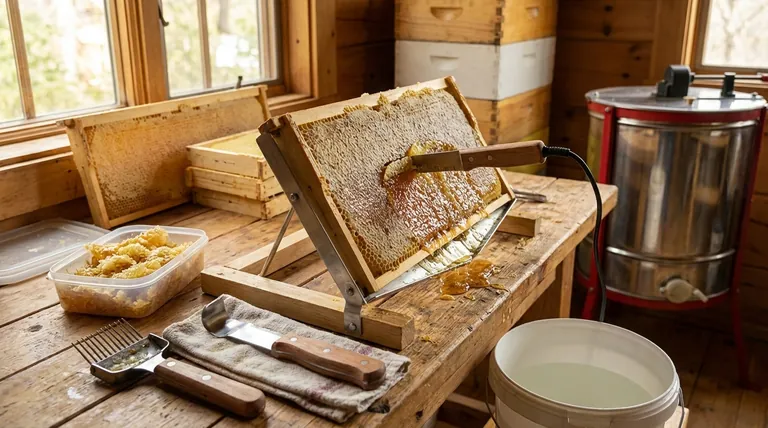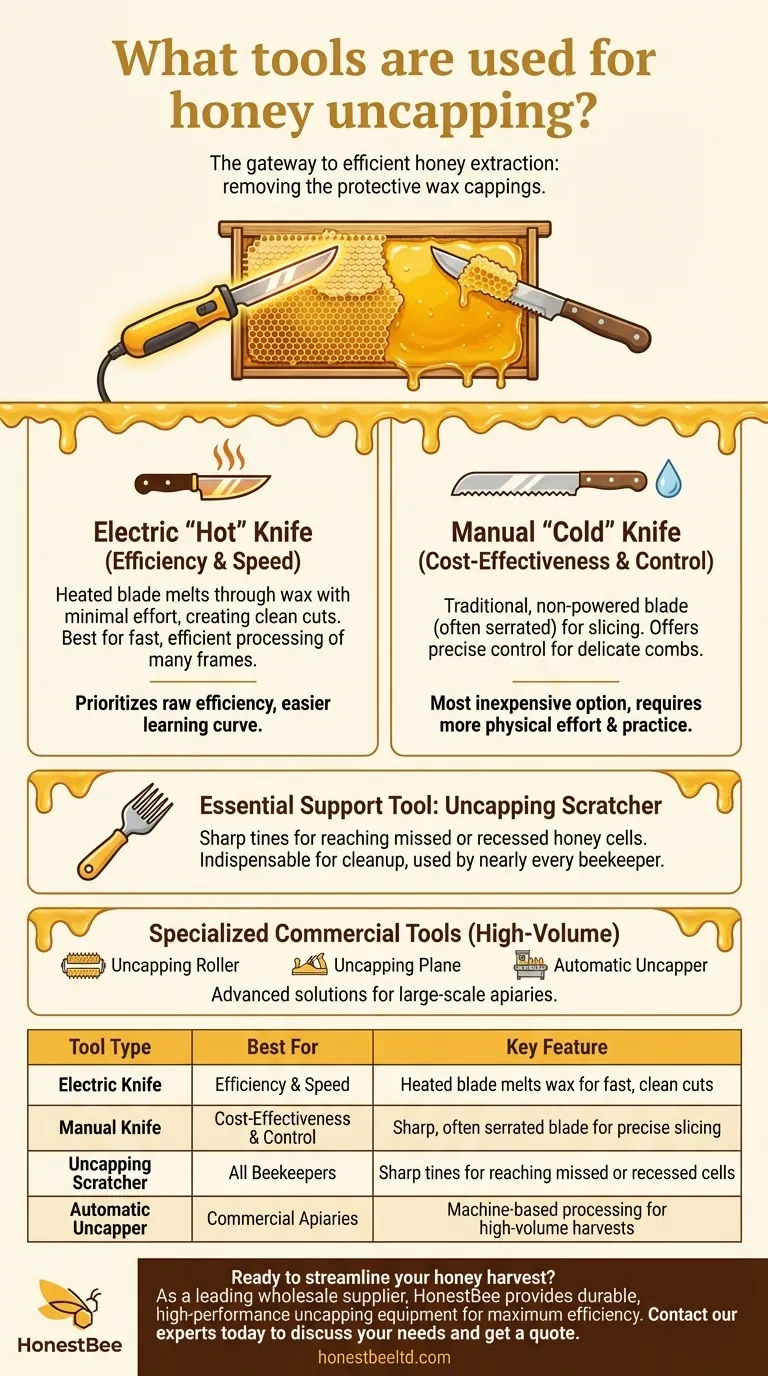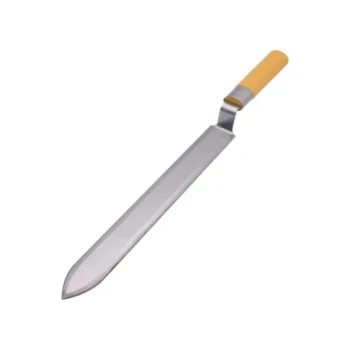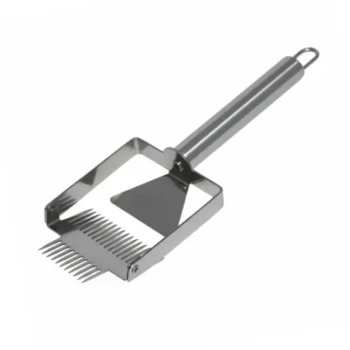The primary tools for honey uncapping are knives designed specifically to remove the thin layer of beeswax from a honeycomb. These tools fall into two main categories: electric heated knives that melt through the wax and manual "cold" knives that slice it off. The choice between them, along with supporting tools like uncapping scratchers, depends entirely on the scale of your beekeeping operation.
The core decision for most beekeepers is choosing between the speed and ease of an electric heated knife versus the control and low cost of a manual cold knife. Understanding this trade-off is the key to selecting the right tool for your harvest.

Why Uncapping is a Critical Step
Before diving into the tools, it's essential to understand the purpose of uncapping. This single step is the gateway to efficiently extracting honey from the frames.
The Purpose of Wax Cappings
Bees are meticulous creatures. Once they fill a hexagonal cell with honey and reduce its moisture content, they seal it with a fresh layer of beeswax. This wax capping protects the honey from moisture and contaminants, preserving it indefinitely.
Preparing for Extraction
To harvest the honey, you must first break this protective seal. Uncapping removes the wax caps, exposing the honey-filled cells. This allows the honey to flow out freely when the frames are spun in a centrifugal extractor.
A Breakdown of Uncapping Tools
Each uncapping tool serves a specific purpose, catering to different needs, budgets, and numbers of hives.
The Electric Uncapping Knife (The "Hot" Knife)
This is the most popular choice for beekeepers looking for speed and efficiency. An electric knife has a built-in heating element, often with a thermostat, that keeps the blade hot.
The heated blade melts through the beeswax cappings with minimal effort, creating a clean, smooth cut and making the process significantly faster.
The Manual Uncapping Knife (The "Cold" Knife)
A manual or "cold" knife is a traditional, non-powered tool. It typically features a long, sharp, and often serrated blade designed to slice through the wax cappings.
While it requires more physical effort, it offers excellent control and is the most inexpensive option. Many beekeepers keep a bucket of hot water nearby to dip the knife in, which helps it glide through the wax more easily.
Uncapping Scratchers and Forks
These tools, also known as uncapping forks or punches, feature sharp tines or needles. They are not typically used to uncap an entire frame but are indispensable for cleanup.
A scratcher is perfect for reaching honey cells in low or recessed areas of the comb where a knife might miss. Nearly every beekeeper, regardless of their primary tool, keeps one on hand.
Specialized and Large-Scale Tools
For larger or commercial operations, more advanced tools exist. Uncapping rollers use spikes to perforate the cappings, while uncapping planes shave the wax layer off.
The most advanced solution is an automatic uncapper, a machine that processes frames on a conveyor system. These are exclusively for high-volume commercial apiaries.
Understanding the Trade-offs
Choosing a tool is not just about function; it's about balancing speed, cost, and control for your specific needs.
Speed vs. Cost
The primary trade-off is clear. An electric knife costs more but saves a significant amount of time and effort, especially when processing many frames. A manual knife is very affordable but requires more time and physical work.
Precision vs. Efficiency
A manual knife gives the user precise control, which is valuable for carefully navigating uneven or delicate combs. Electric knives prioritize raw efficiency, quickly uncapping standard frames with ease.
The Learning Curve
Beginners often find an electric knife easier to use, as the heat does most of the work. A cold knife requires more practice to achieve a clean, even cut without taking too much honey or leaving cappings behind.
Making the Right Choice for Your Apiary
Your decision should be based on the size of your apiary and your primary goal for the honey harvest.
- If your primary focus is cost-effectiveness for a few hives: A manual (cold) knife paired with an uncapping scratcher provides complete control at the lowest possible cost.
- If your primary focus is efficiency for a growing apiary: An electric (hot) knife is a worthwhile investment that will dramatically reduce your harvesting time and labor.
- If your primary focus is high-volume commercial processing: An automatic uncapper is the necessary equipment for handling hundreds or thousands of frames.
Selecting the right uncapping tool transforms honey harvesting from a chore into an efficient and rewarding process.
Summary Table:
| Tool Type | Best For | Key Feature |
|---|---|---|
| Electric Knife | Efficiency & Speed | Heated blade melts wax for fast, clean cuts |
| Manual Knife | Cost-Effectiveness & Control | Sharp, often serrated blade for precise slicing |
| Uncapping Scratcher | All Beekeepers | Sharp tines for reaching missed or recessed cells |
| Automatic Uncapper | Commercial Apiaries | Machine-based processing for high-volume harvests |
Ready to streamline your honey harvest?
As a leading wholesale supplier to commercial apiaries and distributors, HONESTBEE provides the durable, high-performance uncapping equipment you need for maximum efficiency. Whether you're scaling up to an electric knife or require robust tools for a large operation, we have the solutions to save you time and labor.
Contact our experts today to discuss your specific needs and get a quote on the right tools for your apiary.
Visual Guide

Related Products
- Professional Compact Multi-Function Uncapping Knife for Beekeeping
- Stainless Steel Pivoting Honey Uncapping Fork with Plastic Handle
- Professional Stainless Steel Double-Sided Honey Uncapping Knife
- Stainless Steel Dual Blade Uncapping Plane
- Professional Honey Uncapping Fork Tool with Customizable Tine Options
People Also Ask
- Why is it recommended to have multiple hive tools? Boost Efficiency & Prevent Downtime
- Why do you uncap honey? Unlock Your Harvest with Efficient Uncapping
- How does a modified hive tool improve the uncapping of brood? For Precise Varroa Mite Diagnosis
- What to use to uncap honey? Choose the Right Tool for Your Apiary
- What is the first step in the honey extraction process? Master the Critical Art of Uncapping



















